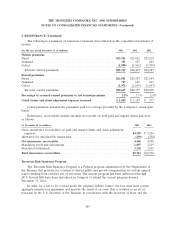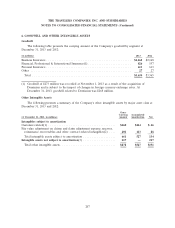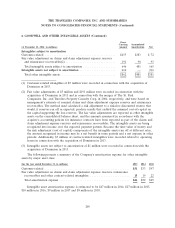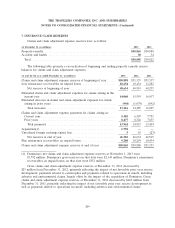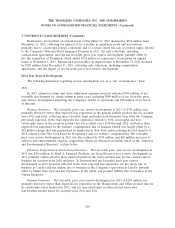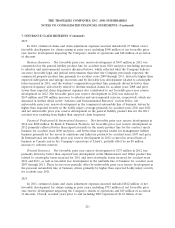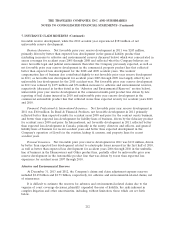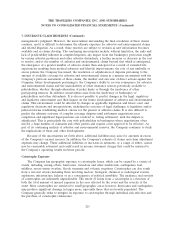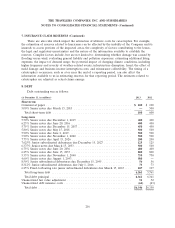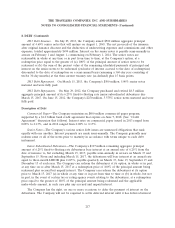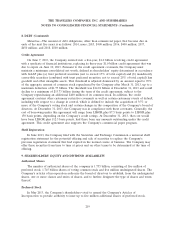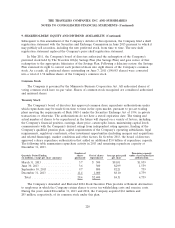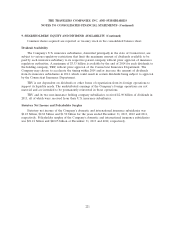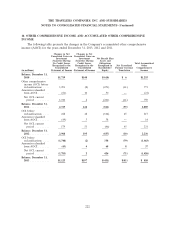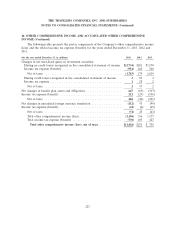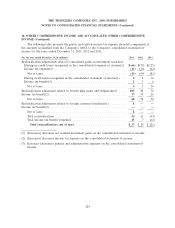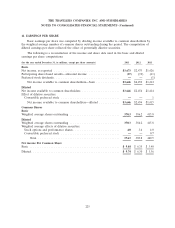Travelers 2013 Annual Report Download - page 225
Download and view the complete annual report
Please find page 225 of the 2013 Travelers annual report below. You can navigate through the pages in the report by either clicking on the pages listed below, or by using the keyword search tool below to find specific information within the annual report.THE TRAVELERS COMPANIES, INC. AND SUBSIDIARIES
NOTES TO CONSOLIDATED FINANCIAL STATEMENTS (Continued)
7. INSURANCE CLAIM RESERVES (Continued)
management’s judgment. However, the uncertainties surrounding the final resolution of these claims
continue, and it is difficult to determine the ultimate exposure for asbestos and environmental claims
and related litigation. As a result, these reserves are subject to revision as new information becomes
available and as claims develop. The continuing uncertainties include, without limitation, the risks and
lack of predictability inherent in complex litigation, any impact from the bankruptcy protection sought
by various asbestos producers and other asbestos defendants, a further increase or decrease in the cost
to resolve, and/or the number of, asbestos and environmental claims beyond that which is anticipated,
the emergence of a greater number of asbestos claims than anticipated as a result of extended life
expectancies resulting from medical advances and lifestyle improvements, the role of any umbrella or
excess policies the Company has issued, the resolution or adjudication of disputes pertaining to the
amount of available coverage for asbestos and environmental claims in a manner inconsistent with the
Company’s previous assessment of these claims, the number and outcome of direct actions against the
Company, future developments pertaining to the Company’s ability to recover reinsurance for asbestos
and environmental claims and the unavailability of other insurance sources potentially available to
policyholders, whether through exhaustion of policy limits or through the insolvency of other
participating insurers. In addition, uncertainties arise from the insolvency or bankruptcy of
policyholders and other defendants. It is also not possible to predict changes in the legal, regulatory
and legislative environment and their impact on the future development of asbestos and environmental
claims. This environment could be affected by changes in applicable legislation and future court and
regulatory decisions and interpretations, including the outcome of legal challenges to legislative and/or
judicial reforms establishing medical criteria for the pursuit of asbestos claims. It is also difficult to
predict the ultimate outcome of complex coverage disputes until settlement negotiations near
completion and significant legal questions are resolved or, failing settlement, until the dispute is
adjudicated. This is particularly the case with policyholders in bankruptcy where negotiations often
involve a large number of claimants and other parties and require court approval to be effective. As
part of its continuing analysis of asbestos and environmental reserves, the Company continues to study
the implications of these and other developments.
Because of the uncertainties set forth above, additional liabilities may arise for amounts in excess
of the Company’s current reserves. In addition, the Company’s estimate of claims and claim adjustment
expenses may change. These additional liabilities or increases in estimates, or a range of either, cannot
now be reasonably estimated and could result in income statement charges that could be material to
the Company’s operating results in future periods.
Catastrophe Exposure
The Company has geographic exposure to catastrophe losses, which can be caused by a variety of
events, including, among others, hurricanes, tornadoes and other windstorms, earthquakes, hail,
wildfires, severe winter weather, floods, tsunamis and volcanic eruptions. Catastrophes can also result
from a terrorist attack (including those involving nuclear, biological, chemical or radiological events),
explosions, infrastructure failures or as a consequence of political instability. The incidence and severity
of catastrophes are inherently unpredictable. The extent of losses from a catastrophe is a function of
both the total amount of insured exposure in the area affected by the event and the severity of the
event. Most catastrophes are restricted to small geographic areas; however, hurricanes and earthquakes
may produce significant damage in larger areas, especially those that are heavily populated. The
Company generally seeks to mitigate its exposure to catastrophes through individual risk selection and
the purchase of catastrophe reinsurance.
215


